Guidelines for encouraging healthy play
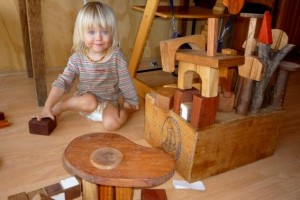
Pretend, socio-dramatic play has been found by brain research to be the most beneficial play for children, as it develops executive functions and flexibility in thinking and social interactions. Big construction, exploratory and adventurous play help children to develop all their senses more fully. Young children today are being deprived of opportunities of such healthy play in many ways—with increasing screen time replacing play, toys and equipment which do not encourage open ended imaginative play and the under-appreciation of play as the natural method of learning in young children in early childhood education programmes in some countries. This article aims to give some reminders to parents on how to encourage healthy play in young children.
View/download pdf Play
Toys – Choosing helpful playthings
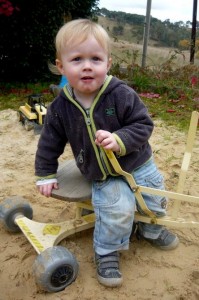 Here are some guidelines for choosing healthy playthings, which meet the needs of young children, encourage initiative and creativity, and develop sound foundations for later learning.
Here are some guidelines for choosing healthy playthings, which meet the needs of young children, encourage initiative and creativity, and develop sound foundations for later learning.
Provide simple “open ended” play things, including natural objects, which encourage imaginative play and give opportunities for large motor activities as well as fine coordination: boxes, cloths, ropes, multi-purpose toys. Toys which do everything and are essentially for watching do not encourage healthy play.
Any materials suitable for cubby building help to meet deep inner needs in the child for their own nest, under a table, in a big box, in the bushes. Note that they gain much more from being able to make it themselves! Our task is to provide basic materials if needed. Of course a little snack for eating in it might also be greatly appreciated.
Where possible provide toys made of beautiful natural materials which are what they appear to be (especially in weight) and which feel good to handle. Especially avoid fluorescent coloured plastic; some European studies have linked over-exposure to fluorescent colour with eye damage.
Provide toys which are strong and well made, and which allow healthy purposeful explorations without breaking. Toys which break quickly are a hazard around very young children. A few good quality items are all that is needed. Quality not quantity.
Children’s tools for gardening, cooking and carpentry should work properly! Cut down the handles to make a broom that a child can really sweep with, a rake a child can really rake with, a good spade to dig with. Geologist spades are good for this. Provide a small hammer with weight that will drive nails in, a rolling pin heavy enough to really roll biscuit dough. Avoid plastic imitations of tools.
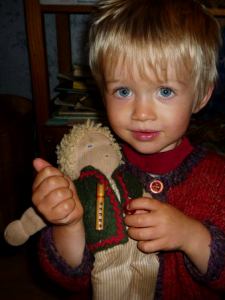 All children need a good doll of their own, one that can become his or her “companion doll”, the favourite doll, ensouled or brought to life in the child’s imagination. The therapeutic value of doll play should not be underestimated. Girls and boys need dolls to love and care for, dolls they identify with as human beings, to be tender with, even to be cross with, to be themselves with. A good doll is one that you intuitively want to pick up and cuddle, one with softness, roundness, a well-proportioned child’s face, one that draws tenderness out of you. (Make sure the eyes are not too close together).
All children need a good doll of their own, one that can become his or her “companion doll”, the favourite doll, ensouled or brought to life in the child’s imagination. The therapeutic value of doll play should not be underestimated. Girls and boys need dolls to love and care for, dolls they identify with as human beings, to be tender with, even to be cross with, to be themselves with. A good doll is one that you intuitively want to pick up and cuddle, one with softness, roundness, a well-proportioned child’s face, one that draws tenderness out of you. (Make sure the eyes are not too close together).
Include the provision of experience playing with delicate beautiful objects like fragile shells, crystals, tiny fine china cups and small art pieces— we often underestimate children’s capacity for gentle handling of things but children can be taught to play gently; this may need adult supervision or ‘special play’ times but is an important experience for children and teaches them respect for objects and beauty. It prepares the way for the tender care of nature, the picking of a delicate flower, the handling of a ladybird. Teach them this at one of the more gentle, cooperative ages or times if this is possible.
Provide toys which take into account the young child’s view of the world. For example children like to see the wholeness of things so providing them with jigsaws which respect the integrity of the shapes and do not cut through whole shapes in an arbitrary way respects their way of seeing the world (for example divide the house into roof, chimney, walls, windows etc.). Adult jigsaws do not do this.
Limit the number of toys a child has available at any one time. Most First World children have far too many toys. Identify which toys the child is truly attached to, especially those ensouled with feelings by the child, and respect the keeping of these. For the others—it may help to have a “magic box” with special toys to bring down when parents are distracted (e.g. by telephones and conversations!) and a “sharing box” for when visitors come, so that small children learn about what is legitimately “part of themselves” (my hat, my mug, my special doll), and what is for sharing. Other good but too numerous toys can be given a holiday in the top cupboard. Others again can be given away altogether. Kim John Payne and Lisa Ross’s book Simplicity Parenting can help with this simplifying process.
Provide the child with honest “gestures” of human and animal, not caricatures and exaggerations. Children need honesty and beauty to surround their sensitive unfolding souls. Consider what nurtures this sensitivity to aesthetics and what does not. True beauty seems to have a very low priority in the toy industry! Let animal toys also have the endearing qualities of a baby animal which encourages loving and respectful play, rather than represent a cartoon character.
Consider the values behind the toys you give (e.g. violence, sexism, racism, corporate images sold by advertising to children). Providing children with ready-made guns is saying guns are acceptable to you; it is different when a child makes a “gun” out of a stick, though you may still consider what you accept or not about this. Consider the images you are providing to young girls and boys in their dolls. Do they promote stylised sexual images which you would not want your child to imitate? Do they encourage violent, aggressive play? Are they merely adult fantasies made for children?
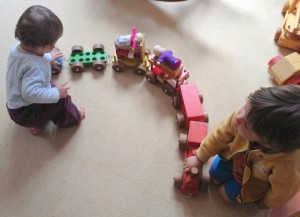 Encourage a broad range of play.If children play a lot with particular toys to the exclusion of imaginative and big play, consider limiting play with those toys to keep a balance in play. Interlocking construction block toys, which children love, can fall into this category.
Encourage a broad range of play.If children play a lot with particular toys to the exclusion of imaginative and big play, consider limiting play with those toys to keep a balance in play. Interlocking construction block toys, which children love, can fall into this category.
Try to resist the temptation to meet your own needs as an adult when you buy toys for a child. Ask: what does this child need at this point in his or her development? This will not necessarily be the same as what children want (or have been told by others that they should want!)
Adult encouragement & involvement in play.
Adults can encourage a rich variety of play by their own example, involvement and attitudes. They can expand their children’s play and encourage creativity and independence in their play. However they need also to be wary of taking over children’s own play. The adult role needs to be one of example, enrichment, extension, provider of helpful materials but only sometimes and an appropriately equal partner in the play. Here are some examples:
You can approach your own work with a positive attitude, with will and enthusiasm. Children absorb these qualities into their own work and play simply by being with you and imitating you.
You can let children actually work with you at everyday tasks, in an age appropriate way. The aim is to find the component in any task that the two, three etc. year old can manage. For example a very young child can cut a banana with a blunt knife but may run into trouble cutting a hard carrot with a sharp knife. Teach them skills by degrees. This builds their self-confidence and competence as well as providing a rich source of ideas for their imaginative play.
You can help children to learn how to play constructively by “modelling” ways to use materials imaginatively, helping them to begin, extend or end play. This can lead toddlers into more creative play and awaken the ability to play in the older child who is not playing very constructively or creatively. For example, when you give them a big cardboard box you might say : “What a wonderful little house this is for someone very small. All it needs is a door…” (and a knife to cut it out). Or to extend play “That’s a fine boat you have. Do you need some oars (sticks) or a sail (a cloth on a broomstick) and some provisions (water and dried fruit) to go on an adventure over the sea.” Or to bring play to a conclusion with packing up the toys: “Oh and look over here, see how this little one is hiding from us. We might have to sing him a little song about coming home to the toy basket. Encourage play by participating in it occasionally from the periphery, like when they are playing mudpies: “Mmm! Doesn’t that smell good!” Create an imaginative world for your child and invite him or her into it, or enter imaginatively into their world of play.
This does NOT mean playing for hours with children. It does mean being conscious of when children need a little help, and knowing how and when to withdraw and leave them to it! In the past children learnt this naturally from their siblings, but many children today do not have siblings to imitate. Let your eventual aim be to get children playing creatively without you, entertaining themselves and enjoying being independent in it.
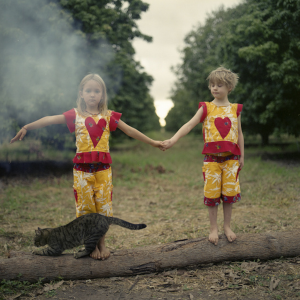
Respect and value their play by not interrupting it unnecessarily. Help to bring it to a gentle end when it is necessary to end play. Give warnings. When you can, enter imaginatively into the child’s game and lead it to a conclusion. “What a busy day all the dolls have had. Time for them all to have a little rest. Here is a blanket to make them a bed.” “That truck has done a good lot of work. Time to give it a clean-up and put it back in its garage.”
Explore different dimensions of experience possible in play with children. Consider play with air, with water, with the earth as well as play with toys! Water play can be particularly soothing, even just play in a sink. Take them into nature and wild places where they have time to potter and play, and learn respect for nature with you.
Collect natural objects with possibilities for play on excursions with the children e.g. interesting stones, seeds, shells, wood, leaves, bark.
Be ready to provide more inward, calming experiences to counteract the over-stimulation the outside world often brings. Whisper! Also recognise when play itself is becoming over-stimulating: signs are screeching, squealing, “out-of- boundness” and over-excitement; step in before trouble occurs. Also avoid outside play in strong winds!
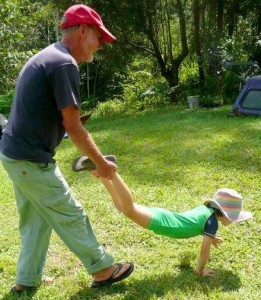 Encourage creativity and playfulness in each other, and play together as a family. One cannot overestimate the value of play and laughter as a de-stressor in a stressed world for young and old alike. There are many avenues for play beyond the imaginative, pretend and construction play of children: physical movement games, drama, word-play, singing games, musical fun and so on. Let the child’s interests also lead you to possibilities. And don’t forget traditional children’s games with balls, and as they get older, skipping ropes, stilts, marbles, hopscotch, for example. But let the key words be active play not passive entertainment, let it be really playing together.
Encourage creativity and playfulness in each other, and play together as a family. One cannot overestimate the value of play and laughter as a de-stressor in a stressed world for young and old alike. There are many avenues for play beyond the imaginative, pretend and construction play of children: physical movement games, drama, word-play, singing games, musical fun and so on. Let the child’s interests also lead you to possibilities. And don’t forget traditional children’s games with balls, and as they get older, skipping ropes, stilts, marbles, hopscotch, for example. But let the key words be active play not passive entertainment, let it be really playing together.
Let your children experience adventure, risk and courage in their play. Where will children learn to be courageous, resilient and wisely assess risk if they never have the chance to practice these things, in little ways, in everyday play, with you as a guide. Hovering, anxious parenting is having a destructive effect on children’s development because children are being held back from doing things most children in the past did without thinking, from climbing an “A frame” in a kindergym, to climbing trees!
There is always risk in life. Of course parents should assess risk and try to make environments safe for children. There is no question about that. We put fences around our swimming pools. But we also need to teach our children how to swim. Otherwise they will go out into the world unable to be safe near any water, afraid to be near it, to sail, to surf, to paddle in the ocean, to sit on a rock above a mountain pool.
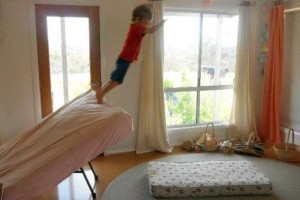 We are in danger of producing a generation of children who are risk averse, without the confidence to try, to be adventurous, courageous, to be able to assess risk wisely. What a tragedy for us all and the earth. Teach your children about risk and courage, about trust in themselves and about acceptance that sometimes they may fail or fall, about how they can pick themselves up again and try again if they want to. Sometimes, as our children grow older, we adults need to be able to just look away and trust, confident in the belief that children grow when they can play with some risk.
We are in danger of producing a generation of children who are risk averse, without the confidence to try, to be adventurous, courageous, to be able to assess risk wisely. What a tragedy for us all and the earth. Teach your children about risk and courage, about trust in themselves and about acceptance that sometimes they may fail or fall, about how they can pick themselves up again and try again if they want to. Sometimes, as our children grow older, we adults need to be able to just look away and trust, confident in the belief that children grow when they can play with some risk.
Be aware that research has shown clearly that excessive screen time is extremely detrimental to creative play. If you believe in play and healthy development then severely limit screen time for young children. Consider not having it as a regular activity for children under ten at all! Excessive screen time not only disrupts healthy play and the development of imagination, it also affects academic achievement, family communication and many other things. See more below.
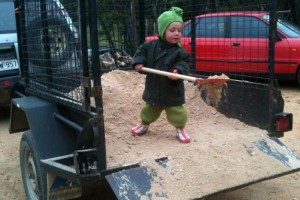
Real physical & social experiences in play versus technology
You cannot hurry the unfolding of the butterfly from its cocoon. If you do (or when you bring some things on too soon) you interrupt the natural process of its transformation and it becomes tragically crippled.
There is deep concern that many young children today are not developing normally, both in the development of physical movement and in their senses. For full development they need repeated and varied experiences in three dimensional space. Children need to be able to experience the natural progression of physical development and to have real physical and social experiences through play.
Here lies the major problem with new technologies for children. Time formerly spent in physical, social and imaginative play is increasingly spent in screen time, in using small electronic gadgets, games and toys, and “entertainments” where the children’s movement and experiences are severely minimised.
‘Virtual’ experiences, amazing though they may be, cannot replace the physical and social experiences that children need for proper development to occur. We have evolved in a way that is suited to living in a ‘concrete’ material world, and development unfolds in response to living in that world. It needs all the senses to be used and nurtured, just as bones need gravity, uprightness and physical movement to form their strong crystalline structure (our bones change their structure and become weaker after we have been bedridden for just two months. Space programmes have also revealed that lack of gravity interferes with the structure in bones, a problem for astronauts).
The eye needs light, colour and form, seen at distances, up close and in the periphery, to develop fully. This is so with all the senses. A compromised sensory environment creates compromised senses and compromised movement.
Regardless of whether or not the electronic gadgets used (or programmes watched) are harmless in themselves, they are displacing other activity important to healthy growth in children.
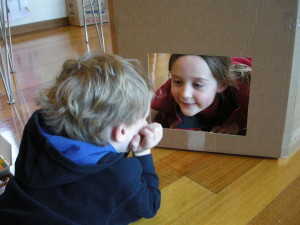
Most professional advice suggests children under two should have no screen time at all, but very few parents heed this advice. Screen time trends show alarming increases in time spent with electronic gadgets and screens in children of all ages over the last 10 years. Parents need to be courageous in choosing what is best for their children, not what seems easiest or most acceptable to others. There can be a surprising amount of resentment in some people towards those who choose to limit screen time and technologies with young children. Perhaps it confronts them and makes them think about what they are doing themselves with their own children, when they may be reluctant to do this. Be aware and prepared for this. Dealing with other people’s attitudes can be what takes the most courage.
Though it may seem hard work at the time, in the long run it is more than worth minimizing screen time and technology when children are young. When children are given maximum time to play and experience the real world fully they will be more creative, more imaginative, have more initiative, better social and intellectual skills and much more, all of which should make your and their life easier and richer when they are older. (See reference below for the value of play and minimizing technology.)
It is also important to be aware of balance here. 30 minutes a week of screen time and electronic gadgets is very different than 3 hours a day (one estimate for screen time for 70% of two year olds.)—that is three hours a day of not playing, not conversing, not observing, not practising new skills. One just needs to be wise, not dogmatic, about this.
Children not only need active physical play, but also truth and reality in their experiences for the healthy development of their senses: the taste of real strawberries, the real acoustic experience of clapping sticks, violin and whistle, true visual experiences of the colour of spring flowers and the sunrise and the movement of ants and the clouds. They need to truly experience space, in the stars at night, in hill top views and holes in the ground. They need to feel gravity, weight and spatial orientation, in upside-down-ness and giddiness. They need to walk on uneven ground, with stones and rocks and grass, and splash through puddles and to feel the sand or oozing mud between their toes. They need real experiences of human warmth and enthusiasm, to imitate their parent’s skills and feel the joy in doing and achieving, to delight in words, in nursery rhymes and funny stories spoken with a real twinkle in the eye of someone who loves them and they love. There are no substitutes for these.
For their healthy growth and play, they need the real, old fashioned reality of the world, the world of humans and nature. When they have this as a basis then, in appropriate small doses at first, we can introduce new electronic technologies. In this way, like our slowly evolving humanity, they can learn to use our amazing new technologies slowly, wisely and appropriately.
View/download pdf Play
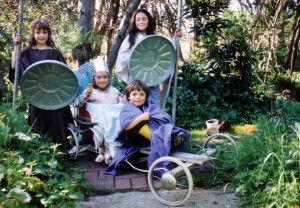
Further reading
For research on the importance of play, risk in play and the effects of new technologies on children go to the Alliance for Childhood website: www.allianceforchildhood.org
Payne, Kim John, with Lisa M. Ross Simplicity Parenting Using the Extraordinary Power of Less to Raise Calmer, Happier and More Secure kids (Ballantine Books Trade Paperbacks, New York, 2009) Or visit their website www.simplicityparenting.com
See also
Possible present list. This is a reminder list of toys and materials which encourage healthy play, for loving friends and relations to pick from, for presents for your children!
Strategies for healthy living in the family
Building self-esteem and resilience